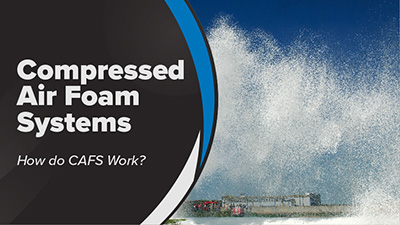How Does a Compressed Air Foam System (CAFS) Work?
Most firefighters are familiar with nozzle aspirated foam systems (NAFS) and how they deliver foam to the fire. Another method of foam delivery is the compressed air foam system (CAFS).
The following is a brief introduction to CAFS and how they work.
Compressed Air Foam Systems (CAFS)
With a CAFS apparatus, there is no need to use a nozzle to introduce air into foam solution to create a finished foam blanket. In a typical apparatus configuration, an on-board rotary air compressor is used to discharge compressed air into foam solution inside apparatus piping, prior to the point where hose lines or fixed monitors connect to fire apparatus.
A phenomenon called “scrubbing” (extreme mechanical agitation) occurs as compressed air and foam solution move through the apparatus piping and/or mixing chamber (a baffled tube), through the hose line and out the nozzle device. Scrubbing produces a much smaller foam bubble structure and converts a high percentage of foam solution (liquid) into a homogeneous mixture of finished foam.
For fire suppression, compressed air foam behaves differently compared to nozzle aspirated foam – it typically has much longer drain times (lasts longer) and can be more durable and useful for specific firefighting applications, both in absorbing heat from fire gases and cooling fuel surfaces.
Is a Nozzle Needed for CAFS?
With CAFS, since “scrubbing” occurs inside piping and hose lines to create the finished foam, a traditional fog or air-aspirating foam nozzle is not required to create or apply a high quality CAFS foam blanket.
As a matter of fact, some fire departments successful with CAFS don’t use a nozzle at all. For the discharge device at the end of a 1-3/4-inch hose line, some use a 1/4-turn pistol grip ball valve, having 1-3/8-inch inside diameter bore. The 1/4-turn ball valve simply provides a means to turn the hose line on and off so the hose team can advance it. The inside bore of the ¼-turn valve is all that is needed for finished foam application.
 |
Some firefighters use a ball valve alone, as a compressed air foam application device, with no smooth-bore nozzle. The TFT F140FP Ball Valve has an unobstructed 1-3/8" internal waterway. The pistol grip is mounted below the valve. Using a ¼-turn ball valve as a nozzle device sounds radical, but keep in mind that a nozzle is not needed to shape, spray or otherwise “make better” high-quality compressed air foam being discharged from the end of a hose line. |
Disadvantages to Using Only a Ball Valve with CAFS
Using a ball valve alone as a discharge device also has several disadvantages, including the inability to create a fog pattern. Importantly, keep in mind that there is no capacity to create an effective fire stream should there be a loss of compressed air from the CAFS pump system. The ¼-turn ball valve butt, used as a nozzle, is just too large an opening to create an effective fire stream when discharging water or foam solution without compressed air.
 |
An alternative to a ball valve alone is the TFT Vortex Nozzle. The waterway is 1-3/8-inch straight through, with the ability to discharge compressed air foam in a solid stream, or when adjusted, as a broken stream. |
Conclusion
CAFS are capable of creating high-quality foam for a variety of applications with or without a nozzle. If you want to use a nozzle, how do you decide which one is right for you?
Take a look at our article on evaluating nozzles for Compressed Air Foam Systems.
